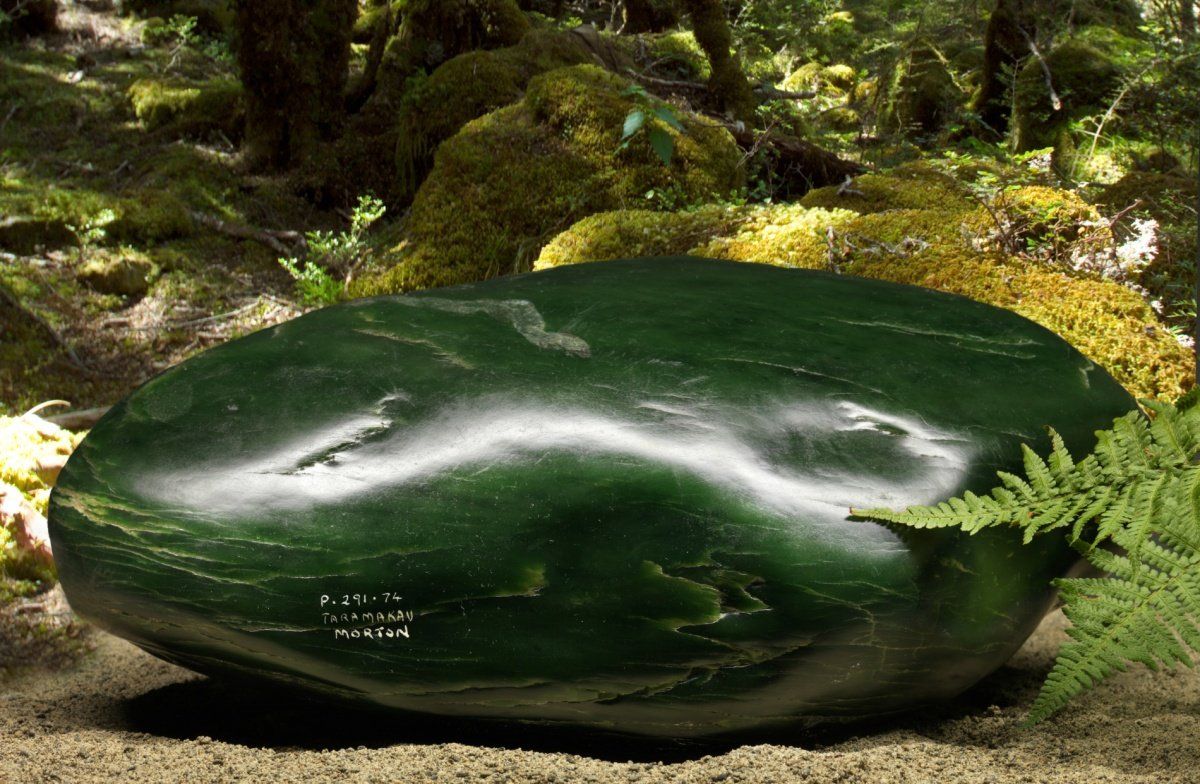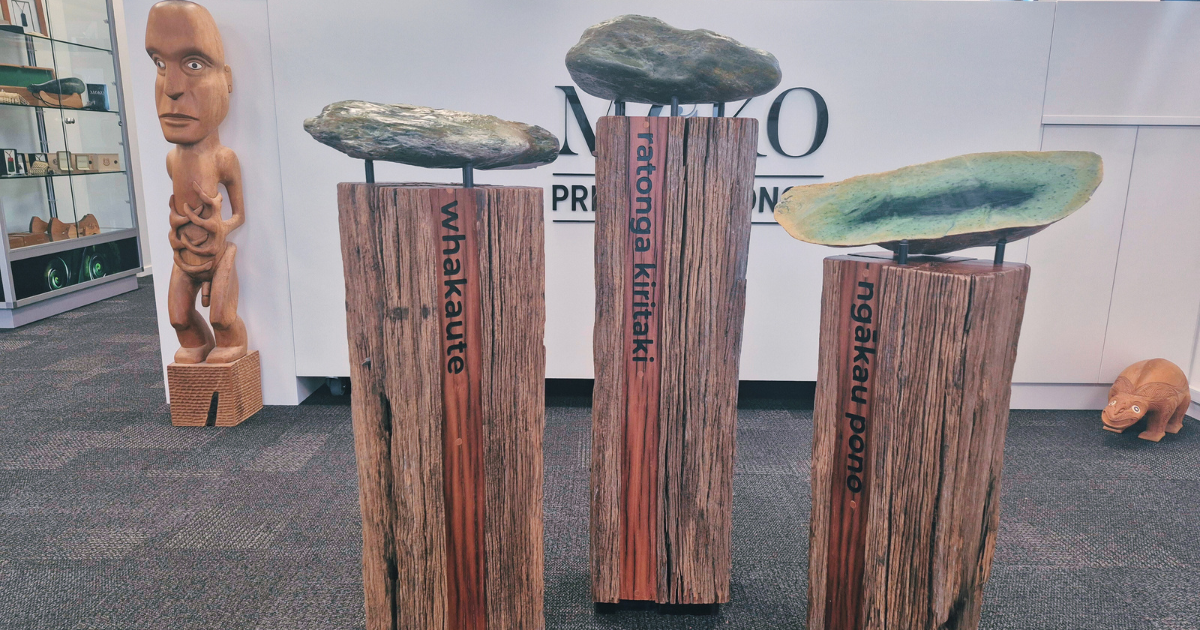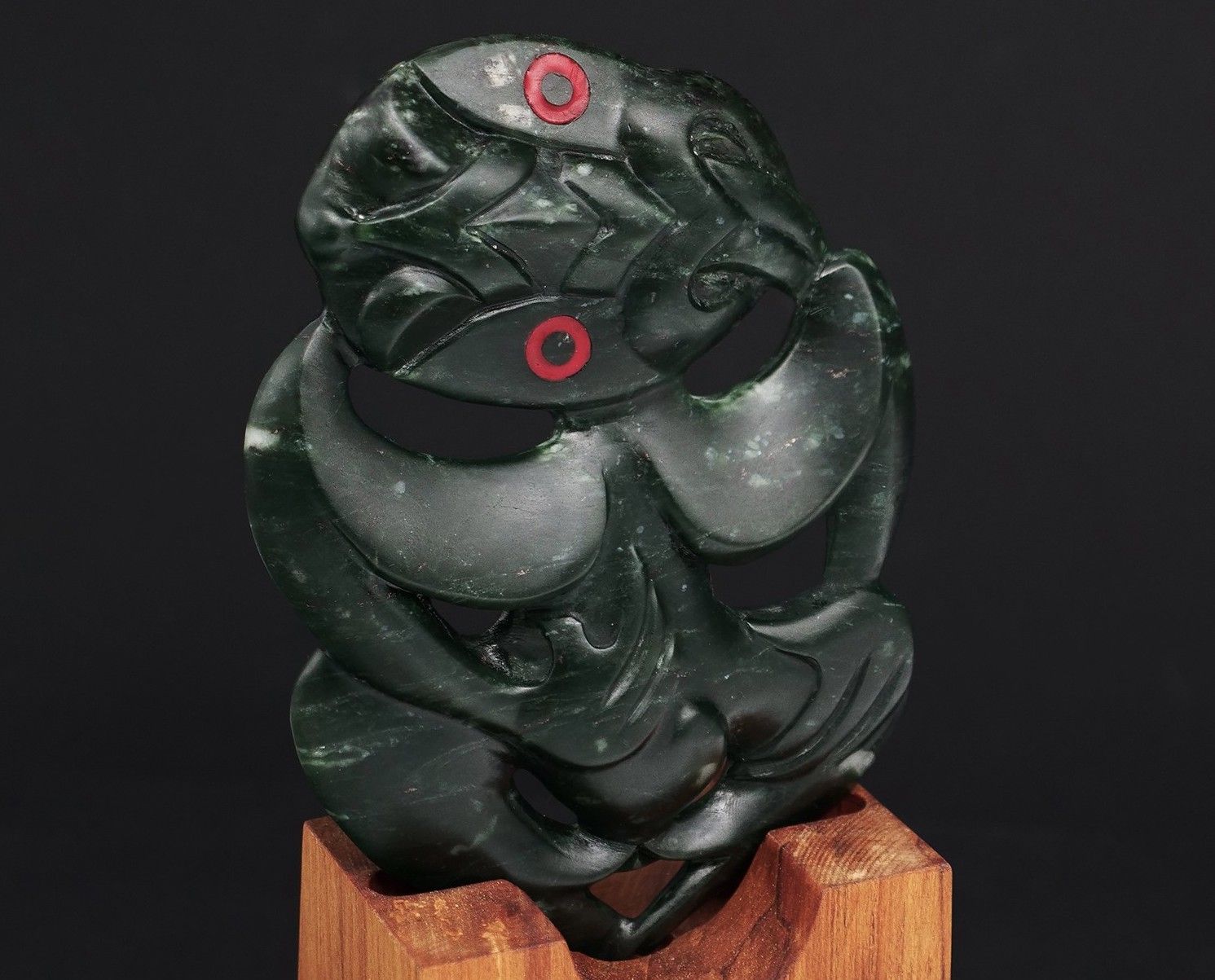
Alf Moreton
All About Alf Moreton
Alfred Moreton was a master carver, a stone expert, and the father of our founder, Deane Moreton. He wrote the book
Te Wahi Pounamu
(The Place of Greenstone) which is an important record of some of the most fascinating stories of pounamu discovery, telling the story of New Zealand nephrite jade and how it came to be known as pounamu - the jade of New Zealand, as well as the different varieties and their characteristics.
Alf’s connection with the West Coast started from birth. He was born in Tetaho in South Westland and spent his first years in Bruce Bay. His family relocated to Hokitika and when Alf was old enough he took jobs that took him out of town: postal service and then the AIr Force. But in 1963 he returned to Hokitika and took a job with the railways - an industry that was booming at the time.
It was while working at the railways that an opportunity arose for another adventure for Alf. Tourism was booming and the government of the day was constructing a new hotel in Franz Josef. The hotel was to be clad in local stone gathered from the nearby Waiho riverbed. Opportunity knocked.
Alf and his brother Morrell secured a contract for the stone cladding and a little over 300 tons of hand-picked stones were gathered for the job, carted to the site and cemented to the walls. This took them 18 months to complete. The stone boulders were gathered from the bed of the Waiho River and carted by tractor and trailer to the site, then cemented to the concrete walls, columns and chimney.
Soon after, an empty building was bought in Hokitika and Alf set up Micastone Products Ltd, which was later named “The Rock Shop.” Alf’s company held mining licences to take schist stone from certain rivers, all hand split on site then stacked on decks and trucked to the new factory. Here it was hammer chipped to shape, then laid out onto frames to form fire surrounds and decorative walls.
Schist is a metamorphic rock found in many places along the West Coast. Because of its many colours it was a popular choice for use in the fire surrounds and wall claddings. It was not uncommon for two men to split and load four tonnes of schist in one day.
Like greenstone, various places produced different coloured schist. Some split easily, such as that gathered from the Waitaha District. This was an even charcoal colour and huge blocks could be reduced to thin slabs within minutes by striking the stone along the grain with steel bolsters and using short-handled, heavy square hammers.
Diedrichs Creek produced beautiful greens of all colours, whilst the Toaroha gave up light browns and more pale shades. The beaches were looked to for gathering pure quartz stones and flat pebbles, these were usually used for garden enhancement and beautification.
In 1965 Micastone Products Ltd was successful in gaining a contract for the supply of 400 tiles, to be used in the construction of the Katherine Mansfield Memorial in Wellington. A special diamond saw was constructed for the job, enabling the extremely heavy stone slabs, which measured 126cm square by 8cm thick, to be cut into tiles measuring 61cm x 61cm and 46cm x 61cm. Once cut to size, the slabs were re-split to 25mm thick then crated and railed to Wellington. A huge job!
One day, while working amongst a great pile of unsplit stone at the factory, Alf looked up and saw Mac - the manager of Westland Greenstone Ltd. Mac asked Alf if he would finish off the front of their factory for them - he wanted it clad in serpentine with polished agates set into the entrance panels.
Alf started work the very next day, despite the crowds of locals and tourists - some bringing greenstone in for appraisal, and some sorting through large wooden bins on shelves, selecting greenstone priced ar $3.10 per kg. At that time, greenstone was able to be publicly fossicked and it was another draw for the tourism industry.
Alf pretty quickly decided he wanted to work with greenstone instead of schist, and devoted himself to learning all about the best ways to handle the stone, the history and origins of the stone, and what it meant to Te Ao Māori. His neighbour was an expert lapidary (worker who cuts, polishes, and engraves precious stones) and not long after Alf’s decision to foray into the world of greenstone, a close contact of his alerted him to a possible huge greenstone find from a location not normally known for its greenstone.
In May 1970 Alf Moreton purchased the largest alluvial greenstone stone ever found in New Zealand, and possibly the world. It is known as The Nicholson Stone, and it weighed in at over eight thousand pounds. At the time it was the talk of Hokitika and surrounding towns. It broke all kinds of records and provided Alf with a definite ‘in’ to the commercial greenstone industry.
Alf’s connection with the West Coast started from birth. He was born in Tetaho in South Westland and spent his first years in Bruce Bay. His family relocated to Hokitika and when Alf was old enough he took jobs that took him out of town: postal service and then the AIr Force. But in 1963 he returned to Hokitika and took a job with the railways - an industry that was booming at the time.
It was while working at the railways that an opportunity arose for another adventure for Alf. Tourism was booming and the government of the day was constructing a new hotel in Franz Josef. The hotel was to be clad in local stone gathered from the nearby Waiho riverbed. Opportunity knocked.
Alf and his brother Morrell secured a contract for the stone cladding and a little over 300 tons of hand-picked stones were gathered for the job, carted to the site and cemented to the walls. This took them 18 months to complete. The stone boulders were gathered from the bed of the Waiho River and carted by tractor and trailer to the site, then cemented to the concrete walls, columns and chimney.
Soon after, an empty building was bought in Hokitika and Alf set up Micastone Products Ltd, which was later named “The Rock Shop.” Alf’s company held mining licences to take schist stone from certain rivers, all hand split on site then stacked on decks and trucked to the new factory. Here it was hammer chipped to shape, then laid out onto frames to form fire surrounds and decorative walls.
Schist is a metamorphic rock found in many places along the West Coast. Because of its many colours it was a popular choice for use in the fire surrounds and wall claddings. It was not uncommon for two men to split and load four tonnes of schist in one day.
Like greenstone, various places produced different coloured schist. Some split easily, such as that gathered from the Waitaha District. This was an even charcoal colour and huge blocks could be reduced to thin slabs within minutes by striking the stone along the grain with steel bolsters and using short-handled, heavy square hammers.
Diedrichs Creek produced beautiful greens of all colours, whilst the Toaroha gave up light browns and more pale shades. The beaches were looked to for gathering pure quartz stones and flat pebbles, these were usually used for garden enhancement and beautification.
In 1965 Micastone Products Ltd was successful in gaining a contract for the supply of 400 tiles, to be used in the construction of the Katherine Mansfield Memorial in Wellington. A special diamond saw was constructed for the job, enabling the extremely heavy stone slabs, which measured 126cm square by 8cm thick, to be cut into tiles measuring 61cm x 61cm and 46cm x 61cm. Once cut to size, the slabs were re-split to 25mm thick then crated and railed to Wellington. A huge job!
One day, while working amongst a great pile of unsplit stone at the factory, Alf looked up and saw Mac - the manager of Westland Greenstone Ltd. Mac asked Alf if he would finish off the front of their factory for them - he wanted it clad in serpentine with polished agates set into the entrance panels.
Alf started work the very next day, despite the crowds of locals and tourists - some bringing greenstone in for appraisal, and some sorting through large wooden bins on shelves, selecting greenstone priced ar $3.10 per kg. At that time, greenstone was able to be publicly fossicked and it was another draw for the tourism industry.
Alf pretty quickly decided he wanted to work with greenstone instead of schist, and devoted himself to learning all about the best ways to handle the stone, the history and origins of the stone, and what it meant to Te Ao Māori. His neighbour was an expert lapidary (worker who cuts, polishes, and engraves precious stones) and not long after Alf’s decision to foray into the world of greenstone, a close contact of his alerted him to a possible huge greenstone find from a location not normally known for its greenstone.
In May 1970 Alf Moreton purchased the largest alluvial greenstone stone ever found in New Zealand, and possibly the world. It is known as The Nicholson Stone, and it weighed in at over eight thousand pounds. At the time it was the talk of Hokitika and surrounding towns. It broke all kinds of records and provided Alf with a definite ‘in’ to the commercial greenstone industry.
Alf’s “Rock Shop” soon became the Hokitika Jade Company Ltd, quickly constructed and filled with various pieces of state of the art machinery to cut down and craft the stone.
Glassed-in viewing areas in the new factory allowed tourists to see into the workshop, rather than wander at will amongst the polishers, interrupting production. The Nicholson Stone was also on display, set on a concrete plinth together with text describing its history which proved to be a great attraction.
Business was hectic. The factory was open seven days a week and employed seven staff plus sales representatives on the road selling jewellery to an ever-increasing market.
The company received a major boost when they secured a contract to supply cabochons (polished oval shaped gemstones which have not been faceted) to a Blenheim-based company. The demand for cabochons increased significantly after that, and in the first year of Hokitika Jade Company Limited, 65,000 were produced alone. Now take into account the fact that the larger Auckland factories were producing greater quantities than that, and we have some idea of how large the industry was in the seventies.
Hokitika’s flourishing new industry was growing and becoming a significant employer of the locals. People started bringing stones to the new factory, usually after they had been cut and rejected by Westland Greenstone. New competition was welcomed by the local prospectors and ultimately it started to drive the asking price of greenstone up. In 1970 greenstone was fetching up to $5 per kilo.
Everyone who was fit and able seemed to be on the hunt for greenstone and the Arahura River was pegged out from the bridge near the coast to Olderog Creek.
Alfred’s next move was to secure a mining licence, and with the assistance of a trusted right hand man and a very expensive bulldozer ($120 per hour) they embarked on what ended up being a days-long mission to find some more stone.
The irony is, after manoeuvring the bulldozer carefully near the headwaters of the New River, it was when Alf bent down to pick up the head of his hammer which had flown off as he hand picked his way through the gravel, that he found a notable stone. The size of a 44 gallon drum and weighing 364 kgs., a waterworn stone of the kahurangi variety showed itself right before his eyes - a special and thrilling moment.
With Alf’s newly acquired mining licence (which in those days took up to 4 years to be approved through the system), he also had gold added to the list when it became apparent that significant gold deposits remained in the spots he was mining.
During the 1980s world gold prices fed a mini gold boom throughout Westland and as a result large amounts of greenstone were uncovered which was also rising in value. Prices for stone had risen to around $40 per kg, not much considering its scarcity. By this time stone was also being imported from overseas.
But despite the stone’s scarcity, Hokitika Jade Company was unable to process the vast amounts that we were bringing in from our mining endeavours. Alf and his team eased off collecting stone, but kept a note of where we wanted to return to collect some. One stone Alf found, estimated to be around 12 tonnes, still lies buried along with a great many others.
Alf held a mining licence until 2001, though greenstone was not able to be commercially mined after the ownership of pounamu was given back to Ngai Tahu in 1997 - meaning they could have full control of who could do what with any greenstone found. An important moment in New Zealand’s history.
Carving was a favourite pastime, and eventually a highly specialised skill of Alf’s and he became one of the most well known New Zealand jade carvers. A true labour of love. In New Zealand, jade is most commonly known as pounamu or greenstone and it is of great importance to the indigenous culture of this land.
Alf is a highly regarded part of New Zealand’s greenstone story and here at Moko Pounamu we’re proud to have him as part of our story too.
Glassed-in viewing areas in the new factory allowed tourists to see into the workshop, rather than wander at will amongst the polishers, interrupting production. The Nicholson Stone was also on display, set on a concrete plinth together with text describing its history which proved to be a great attraction.
Business was hectic. The factory was open seven days a week and employed seven staff plus sales representatives on the road selling jewellery to an ever-increasing market.
The company received a major boost when they secured a contract to supply cabochons (polished oval shaped gemstones which have not been faceted) to a Blenheim-based company. The demand for cabochons increased significantly after that, and in the first year of Hokitika Jade Company Limited, 65,000 were produced alone. Now take into account the fact that the larger Auckland factories were producing greater quantities than that, and we have some idea of how large the industry was in the seventies.
Hokitika’s flourishing new industry was growing and becoming a significant employer of the locals. People started bringing stones to the new factory, usually after they had been cut and rejected by Westland Greenstone. New competition was welcomed by the local prospectors and ultimately it started to drive the asking price of greenstone up. In 1970 greenstone was fetching up to $5 per kilo.
Everyone who was fit and able seemed to be on the hunt for greenstone and the Arahura River was pegged out from the bridge near the coast to Olderog Creek.
Alfred’s next move was to secure a mining licence, and with the assistance of a trusted right hand man and a very expensive bulldozer ($120 per hour) they embarked on what ended up being a days-long mission to find some more stone.
The irony is, after manoeuvring the bulldozer carefully near the headwaters of the New River, it was when Alf bent down to pick up the head of his hammer which had flown off as he hand picked his way through the gravel, that he found a notable stone. The size of a 44 gallon drum and weighing 364 kgs., a waterworn stone of the kahurangi variety showed itself right before his eyes - a special and thrilling moment.
With Alf’s newly acquired mining licence (which in those days took up to 4 years to be approved through the system), he also had gold added to the list when it became apparent that significant gold deposits remained in the spots he was mining.
During the 1980s world gold prices fed a mini gold boom throughout Westland and as a result large amounts of greenstone were uncovered which was also rising in value. Prices for stone had risen to around $40 per kg, not much considering its scarcity. By this time stone was also being imported from overseas.
But despite the stone’s scarcity, Hokitika Jade Company was unable to process the vast amounts that we were bringing in from our mining endeavours. Alf and his team eased off collecting stone, but kept a note of where we wanted to return to collect some. One stone Alf found, estimated to be around 12 tonnes, still lies buried along with a great many others.
Alf held a mining licence until 2001, though greenstone was not able to be commercially mined after the ownership of pounamu was given back to Ngai Tahu in 1997 - meaning they could have full control of who could do what with any greenstone found. An important moment in New Zealand’s history.
Carving was a favourite pastime, and eventually a highly specialised skill of Alf’s and he became one of the most well known New Zealand jade carvers. A true labour of love. In New Zealand, jade is most commonly known as pounamu or greenstone and it is of great importance to the indigenous culture of this land.
Alf is a highly regarded part of New Zealand’s greenstone story and here at Moko Pounamu we’re proud to have him as part of our story too.

Moko Pounamu Knowledge Library

We believe that gifting pounamu is a profound act, one that deserves to be supported by deep knowledge, genuine care, and absolute integrity. This belief is the foundation of our business, which is built on three core pillars that guide every interaction, both in our Christchurch shop and across the globe.




